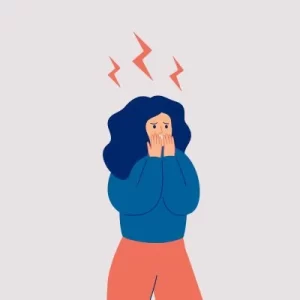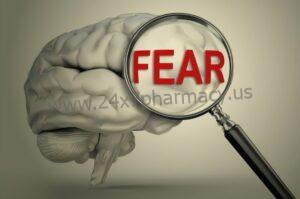If Anxiety is in my Brain , Why is my heart Pounding?

But science has traditionally seen the brain as the birthplace and processing site of fear and anxiety. Then why and how do you feel these emotions in other parts of your body?
I am a psychiatrist and neuroscientist who researches and treats fear and anxiety. In my book “Afraid,” I explain how fear works in the brain and the body and what too much anxiety does to the body. Research confirms that while emotions do originate in your brain, it’s your body that carries out the orders.
Fear and the brain

There are a few key areas of the brain that are heavily involved in processing fear.
When you perceive something as dangerous, whether it’s a gun pointed at you or a group of people looking unhappily at you, these sensory inputs are first relayed to the amygdala. This small, almond-shaped area of the brain located near your ears detects salience, or the emotional relevance of a situation and how to react to it. When you see something, it determines whether you should eat it, attack it, run away from it or have sex with it.
Threat detection is a vital part of this process, and it has to be fast. Early humans did not have much time to think when a lion was lunging toward them. They had to act quickly. For this reason, the amygdala evolved to bypass brain areas involved in logical thinking and can directly engage physical responses. For example, seeing an angry face on a computer screen can immediately trigger a detectable response from the amygdala without the viewer even being aware of this reaction.
The hippocampus is near and tightly connected to the amygdala. It’s involved in memorizing what is safe and what is dangerous, especially in relation to the environment – it puts fear in context. For example, seeing an angry lion in the zoo and in the Sahara, both trigger a fear response in the amygdala. But the hippocampus steps in and blocks this response when you’re at the zoo because you aren’t in danger.
The prefrontal cortex, located above your eyes, is mostly involved in the cognitive and social aspects of fear processing. For example, you might be scared of a snake until you read a sign that the snake is nonpoisonous, or the owner tells you it’s their friendly pet.
Although the prefrontal cortex is usually seen as the part of the brain that regulates emotions, it can also teach you fear based on your social environment. For example, you might feel neutral about a meeting with your boss but immediately feel nervous when a colleague tells you about rumors of layoffs. Many prejudices like racism are rooted in learning fear through tribalism.
Fear and the rest of the body

If your brain decides that a fear response is justified in a particular situation, it activates a cascade of neuronal and hormonal pathways to prepare you for immediate action. Some of the fight-or-flight response – like heightened attention and threat detection – takes place in the brain. But the body is where most of the action happens.
Several pathways prepare different body systems for intense physical action. The motor cortex of the brain sends rapid signals to your muscles to prepare them for quick and forceful movements. These include muscles in the chest and stomach that help protect vital organs in those areas. That might contribute to a feeling of tightness in your chest and stomach in stressful conditions.
It all goes back to the brain
All bodily sensations, including those visceral feelings from your chest and stomach, are relayed back to the brain through the pathways via the spinal cord. Your already anxious and highly alert brain then processes these signals at both conscious and unconscious levels.
The insula is a part of the brain specifically involved in conscious awareness of your emotions, pain and bodily sensations. The prefrontal cortex also engages in self-awareness, especially by labeling and naming these physical sensations, like feeling tightness or pain in your stomach, and attributing cognitive value to them, like “this is fine and will go away” or “this is terrible and I am dying.” These physical sensations can sometimes create a loop of increasing anxiety as they make the brain feel more scared of the situation because of the turmoil it senses in the body.
Although the feelings of fear and anxiety start in your brain, you also feel them in your body because your brain alters your bodily functions. Emotions take place in both your body and your brain, but you become aware of their existence with your brain. As the rapper Eminem recounted in his song “Lose Yourself,” the reason his palms were sweaty, his knees weak and his arms heavy was because his brain was nervous.![]()
